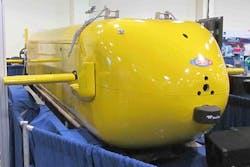Navy to test large unmanned submarine next year in open-ocean voyage down the California coast
Officials of the Office of Naval Research in Arlington, Va., say the Large Displacement Unmanned Undersea Vehicle-Innovative Naval Prototype (LDUUV-INP) is expected to make an ocean voyage off the coast of California next year.
The LDUUV Innovative Naval Prototype (LDUUV INP) project, will develop a large unmanned underwater vehicle (UUV) able to conduct missions longer than 70 days in open ocean and coastal waters.
LDUUV will be launched from a pier or a variety of platforms, including the Littoral Combat Ship (LCS), Navy officials say. The craft's missions will include intelligence, surveillance, and reconnaissance (ISR), acoustic surveillance, anti-submarine warfare (ASW), mine counter-measures, and offensive operations.
Chief of Naval Research Rear Adm. Mat Winter announced last week that the LDUUV prototype will be launched in the ocean off of San Francisco sometime in 2016 and proceed autonomously down the coast to San Diego about 500 miles south.
Winter made his announcement this past week at the Navy League Sea, Air, Space conference and trade show in National Harbor, Md. The LDUUV prototype was displayed publicly for the first time at the Navy League show.
Navy researchers still are testing the endurance and range of the payload-agnostic LDUUV prototype, but say it has operated at sea for more than 30 days at a time.
The LDUUV project's manufacturing and development phase is to begin this year with extensive testing planned for 2018. The large unmanned submarine is expected to reach initial operating capability as a squadron by 2020 and full rate production by 2025, Navy officials say.
Related: Navy asks Metron for autonomy and control software for future large-displacement UUV
In 2011, ONR issued solicitations requesting proposals to develop three technologies for the LDUUV program: energy systems, autonomy in the littorals, and endurance technologies. In June 2012, ONR awarded a $5.9 million three-year, sole-source contract to Hydroid Inc. in Pocasset, Mass., to develop an autonomy testing system. Hydroid will use its REMUS vehicle to test these technologies.
In July 2012, ONR awarded FuelCell Energy Inc. in Danbury, Conn., an 18 month $3.8-million phase-one contract to develop and test an 1,800-kilowatt-hour hybrid solid oxide fuel cell (SOFC)-battery power system.
Sierra Lobo Inc. of Fremont, Ohio was also awarded a $20 million research contract to develop a cryogenic fuel cell-powered undersea vehicle energy system.
On 20 July 2012, Hamilton Sundstrand was awarded an $18 million contract to develop an energy-dense air independent power system for the program. The system will consist of a proton exchange membrane fuel cell (PEMFC), and cryogenically-stored fuel and oxidant.
Other propulsion development awardees include General Atomics in San Diego; Lynntech Inc. in College Station, Texas; and NexTech Materials Ltd. in Lewis Center, Ohio.
For more information contact the Office of Naval Research online at www.onr.navy.mil.
